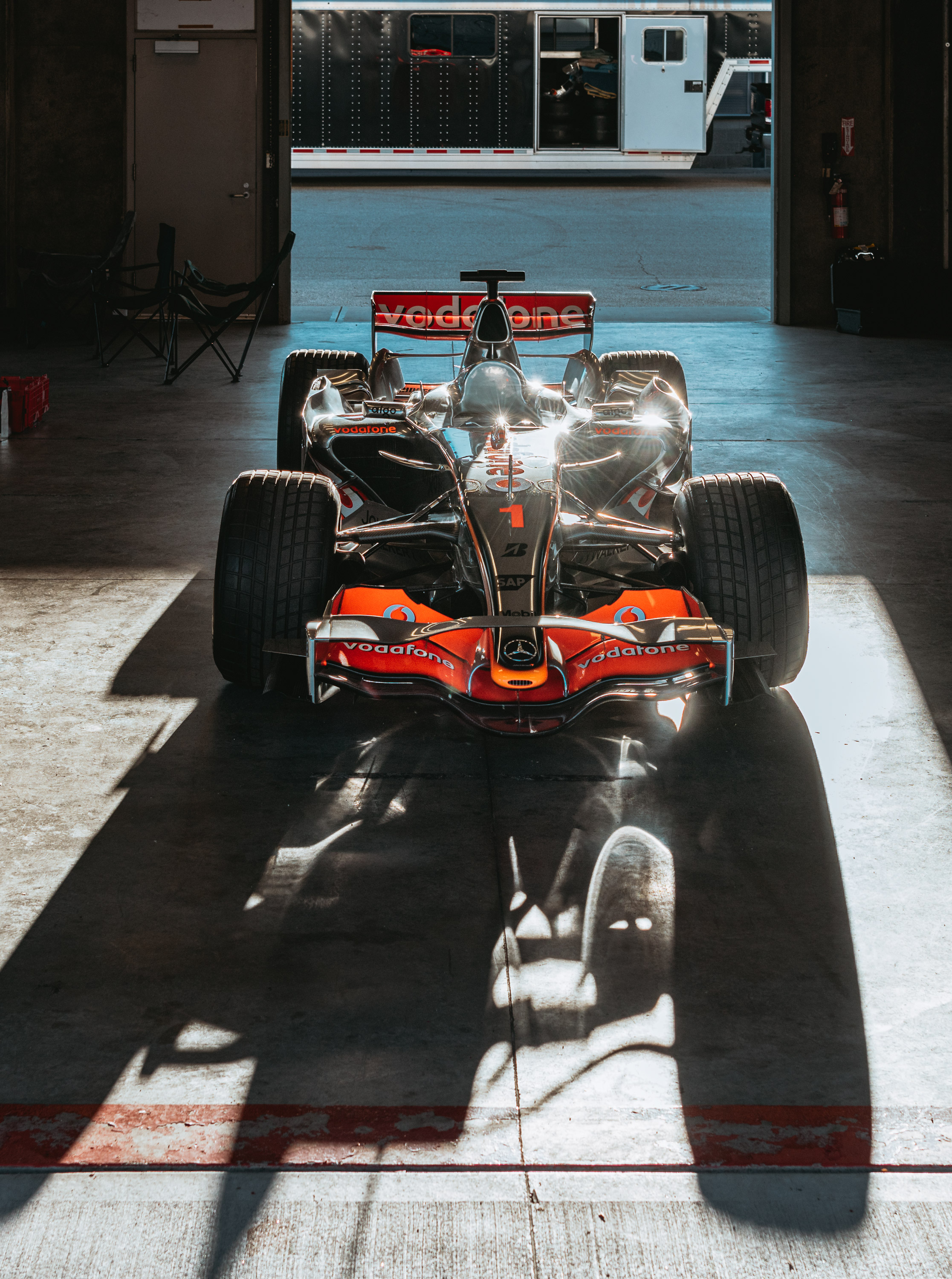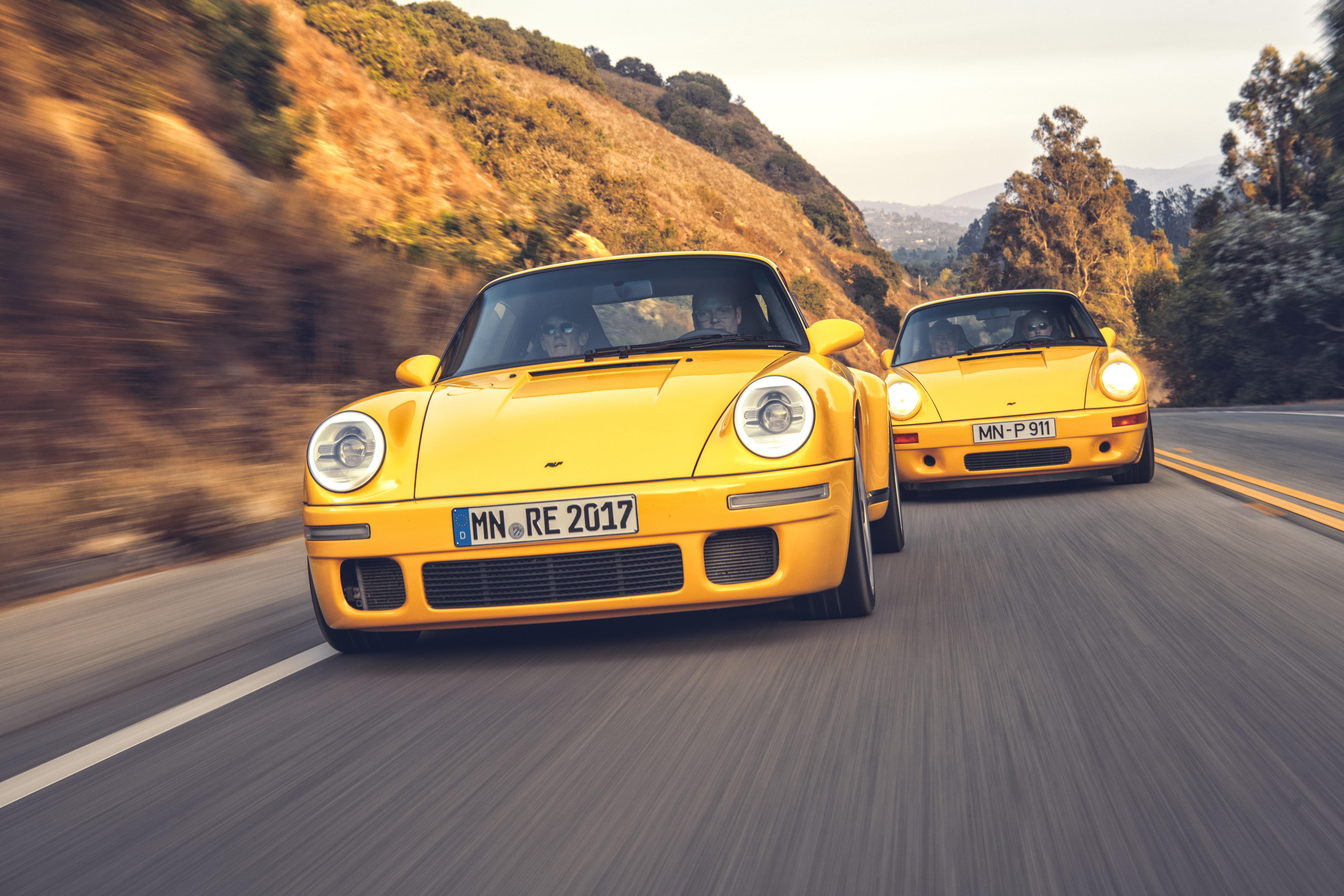Car-to-car shots are one thing, but car-to-Formula-One-car shots are … madness. I accompanied Sam Smith for Road & Track to Indianapolis where he drove Fernando Alonso’s Monaco winning McLaren MP4-22 around the road course. That top photo was taken at a ridiculously high speed from the passenger seat of a Corvette. I’ve never shot leaning over the side of a car going that fast before. More on that later.
First, a little bit about this car. It’s no backmarker. Fernando Alonso used the MP4-22 to win four grand prix for McLaren in 2007 – including Monaco, in this very chassis – while teammate Lewis Hamilton racked up four wins of his own. So, McLaren won eight of the seventeen F1 races in their MP4-22, nearly half the season. So, that means *does some math on a pizza box* this car, by anyone’s standard, is goddamn fast. The only cars that could come close or better in 2007 were the Ferraris; Kimi Raikkonen won the driver’s world championship in his Ferrari at the last race of the season, but only by a single point, with Alonso and Hamilton tied for second.
This car is now privately owned, and Sam was given the chance to drive it during an afternoon when the car’s current owner was getting some seat time. So how does this work? Can you just buy a 2007 McLaren F1 car and show up at the track, back it off the trailer and drive it? Good question! No! You can’t come close to getting this thing started without the help of a team of engineers who have started it before, and they can’t do it without half the contents of Alonso’s transporter from 12 years ago. Ordinarily when you hear of some billionaire buying so-and-so’s F1 car it’s really just a gutless shell used to festoon a wall in their garage/lair. The things you’d need to actually *run* a twelve year old F1 car are much harder to come by.
But, as is often the case, if your yearly disposable income budget is something along the lines of the GDP of a developing country, anything is possible. All you have to do is foot the bill for McLaren to fly a team of former and current Formula One engineers from England to Indiana for the weekend. They’ll wear McLaren shirts, plug in some ancient laptops, and take care of everything. They’ll even bring tire blankets. That’s what was happening here. Full on F1 Fantasy Camp.
The car was in and out of the garage all day, a couple laps here, some tuning, then a couple laps there. Sam drove it, he looked fast, and he didn’t crash. I even watched him lock the brakes up a little. Good man. The sound of the Mercedes-Benz naturally-aspirated V8 firing up inside Indy’s garages for the first time was something else. It’s so loud it knocked my phone over trying to record it. You cannot remember what you were just thinking about before the sound happened. It’s so great.
As the day wound down, we were given a tiny window to get the tracking shots we needed for Sam’s story. Car-to-car shots are usually done relatively slowly, even on race tracks. For my needs, there is a sweet spot for speed, depending on the road surface: we want a nice slow shutter for a blurred background, while staying smooth enough holding the camera while bouncing down the road that you don’t ruin the sharpness on the subject. Often 35, 40 mph is plenty. But a modern F1 car won’t do that. It just can’t. Well, it can, but for a very short distance before the engine overheats and then explodes.
“Wait a minute,” you say, “what about a full course yellow, when the whole field is shuffling around behind the safety car during a race? That looks pretty slow, no?” Not so much. Look at the safety car closely next time you see it deployed. That driver is straight up booking it around the track. He must, in order to keep enough air flowing into the race cars behind that they don’t self-destruct.
So how fast, or slow is that? I don’t know exactly. But maybe this helps: in 2007, F1’s safety car was a 475 horsepower Mercedes CLK 63 AMG with modified brakes and tires. Its driver, Bernd Maylander, told the BBC in an interview he was driving at “99% of the car’s limit” at all times while pacing the field. It was hard for me to wrap my mind around the fact that the slowest that the McLaren guys would be comfortable with for photography would be around the pace of a CLK 63 AMG on a hot lap.
Obviously, if this was going to work we needed something quick and luckily I had a good combo: Mr. Smith driving a Z51 Corvette. We were given ONE LAP to get our shots. No pressure… It’ll just never happen again.
We got one, totally insane lap. In truth, the McLaren did three laps to our one: he’d pace us for a third of the track then blast away to cool down, reappearing behind us in what seemed like no time at all. I don’t know how fast we were going exactly – it was hard just keeping my eyes behind the camera – but Sam said afterwards that he was driving the Corvette at 9/10ths. I believe him.
Anyway, here are the results of that day, and the resulting R&T cover. Hovering over the gearbox of an F1 car roaring onto the main straight at Indy is something that I (and my ears) will never forget.



































2 comments
Damm great article. I am from Austria Europa. since I was a Baby i watched F1. This cars are so fast and loud. Once I was at a GP in Austria. So thank you for the words and very cool Photos.
I find your Page while o was looking for fascinating Car Photographers- like you.
I will run a Automotiv Photographer Buisness. (Shooting men with thier new cars)
You are my bis Idol and gib es me a Lot of Inspiration.
With you want Check out my Homepage http://www.georglaube.com
I am still at the designing Process.
Best regards
Georg Laube
Thanks Georg – means a lot. Best of luck!